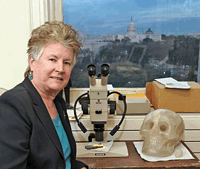Conversations:
Hunting Fakes
January/February 2005
A Smithsonian sleuth says counterfeits lurk in museum
collections the world over.
Jane Walsh, an anthropologist at the Smithsonian's National Museum of
Natural History, is best known for her work with museum collections and for
exposing several crystal skulls, once thought to be Precolumbian, as
nineteenth-century German fakes. She is now working with several museums to
create a database that can be used to identify bogus Precolumbian jade,
crystal, and other stone artifacts. She talked to ARCHAEOLOGY about why you
shouldn't always trust what you see at museums.
Can you say how many fakes are in any one museum's
collection?
Well, no. But what I
can tell you is any museum--I don't care what museum it is--has fakes, because
fakes are ubiquitous. I have a friend who works at the Holocaust Museum as a
conservator, and even they have forgeries--Star of David badges and prison
uniforms that were made for Hollywood films and later sold by dealers as
authentic artifacts.
How did counterfeit Precolumbian jade, crystal, and other
stone artifacts become so prevalent in museum collections?
Museums all over the world began collecting
Precolumbian stone carvings in the 1820s just after Mexican independence, when
the country was first opened again to foreigners. They created a demand, and
there probably wasn't a supply to satisfy that demand. So local artisans, or
maybe some Europeans, started creating the supply. In the beginning, people
were unknowingly collecting the fakes because they didn't know what the things
were supposed to look like.
It seems likely that some forgeries must have made it into
serious scholarly research.
There
are a number of very famous pieces that I wonder about, and people have
published on them for a century. And there are plenty of pieces that are
completely anomalous--that don't look like anything else that anyone has ever
dug up--that have made it into scholars' papers. Those publications are always
filled with complicated explanations of why the objects don't look like
anything else. I think there may be an easier answer. I'm not saying they're
all fakes. I'm saying this project may offer the opportunity to make sure
they're not.
Is that what interests you most about looking for fakes?
It's not just that I want to say, "Oh, that's
fake!" It comes out of my interest in collections and what they say about
us as much as what they say about the people we think made the objects. Fakes
are sort of creatures of their time. A lot of them were made in the nineteenth
century, which was a very inventive age--people had absolutely no compunction
about taking something that was 500 years old and changing it to make it look
"better."
How will you use the stone artifacts from the Smithsonian,
the British Museum, and Mexico's Templo Mayor Museum to identify fakes?
We want to create a database with documented
artifacts from archaeological contexts that we can use to make comparisons with
artifacts in question. Basically, we'll subject objects to various analyses
using silicone impressions, scanning electron microscopes, CAT scans, and x-ray
fluorescence.
Do you worry that the results of your work may tip off the
forgers?
It will get to them. I
know it will. Someone 50 years from now will have to figure out what they
figured out. But by then, this technology that I'm using is going to look like
what they used in the nineteenth century. People will be able to zap a laser
beam at an object and tell immediately that it's from 1963.
How do you think museums will react to your work?
Some people in my department say, "Oh, you
are going to be deluged by people who want you to come and take a look at their
stuff." That's not my fear. My fear is that I'm going to be locked out of
collections because people will be afraid that I'll say their favorite object
is a fake.
I'm already sort of dealing with that at the moment. I
can't really talk about it, but I have to say I was surprised. To me it just
seems like the most obvious thing in the world to do is research your
collection. Otherwise it's kind of like having a library where you won't let
people take the books down because they look so nice, stacked up all evenly.
Collections really are like libraries. The objects are like books and you have
to open them up to learn anything. You can't just admire them through glass
cases.
|
© 2005 by the
Archaeological Institute of America
archive.archaeology.org/0501/etc/conversations.html
|
